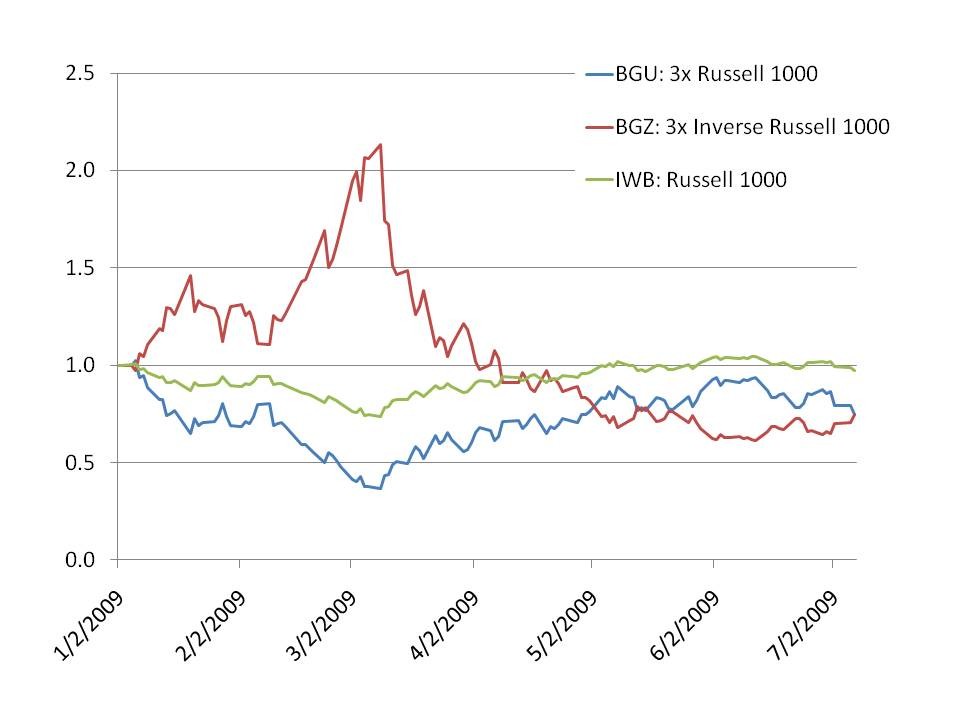Leveraged Versus Traditional ETFs For Dummies
Post on: 15 Апрель, 2015 No Comment

In 2006, ProShares introduced four ETFs targeting investors at the extremely optimistic end of the sentiment spectrum. These are leveraged funds that include the Ultra QQQ (QLD), which “seeks daily investment results, before fees and expenses, that correspond to twice (200%) the daily performance of the NASDAQ-100 Index,” and the similarly designed Ultra S&P500 (SSO), Ultra MidCap400 (MVV), and Ultra Dow30 (DDM).
You think the market is going to rock? These funds, which use futures and other derivatives to magnify market returns, promise to make you twice the money you would make by simply investing in the NASDAQ-100, the S&P 500, the S&P MidCap 400, or the Dow. Of course, youll have to accept twice the volatility. It seems like it might be a fair bet. But it really isnt.
Suppose you invest in the Ultra S&P500 (SSO), as opposed to, say, the SPDR S&P 500 (SPY). On a daily basis, if the underlying index goes up, your investment will go up twice as much. If the underlying index goes down, your investment will go down twice as much. Clearly the volatility is double. But lets look at the potential returns, as well.
The SPY is going to cost you 0.10 percent in operating expenses. The SSO is going to cost you 0.95 percent. Thats a difference of 0.85 percent a year, or $425 on a $50,000 investment. You can expect about 1.8 percent in annualized dividends on SPY.
Because SSO invests largely in futures, you arent going to get much in dividends probably less than half. On a $50,000 investment, thats a difference of an additional $450 or more. Already youve lost $875 ($425 + $450), regardless of which way the market goes.
But it isnt actually the loss of dividends or the high operating expenses that will hurt you the most with leveraged funds. Its more the added volatility daily volatility that will eat up and spit out your principal regardless of which way the market goes.
Suppose you invest $1,000 in the ProShares Ultra QQQ ETF (QLD), which seeks a return of 200 percent of the return of the NASDAQ-100 index (the 100 largest over-the-counter stocks in the land). Now suppose that the index goes up 10 percent tomorrow but then drops 10 percent the day after tomorrow. You think youre back to $1,000? Guess again.
The math of compounding is such that, even if you had invested in the index itself unleveraged youd be in the hole after Day Two. Run the numbers: your 10 percent gain on Day One would take you up to $1,100, but your loss of 10 percent of $1,100 the next day equals $110. Youre left with $990 on Day Two, or an overall loss of 1 percent.

With QLD, youre going to get double socked. On Day One, youll happily be up 20 percent to $1,200. But on Day Two, youll lose 20 percent of that amount and find yourself with $960. You didnt lose the promised double (2 percent); you just lost quadruple (4 percent). Pull out your calculator if you dont believe me.
Unfortunately, you are not helped if the market goes down and then up, instead of the other way around. Lose 10 percent of $1,000 and youve got $900. Gain 10 percent the next day, and what do you have? $990 ($900 + $90).
The situation is magnified with QLD: You would lose 20 percent on Day One for a balance of $800 and gain 20 percent on Day Two to bring you right back to the same $960 you were left with in the first example.
And THAT is how these funds eat up your hard-earned savings.
- Add a Comment Print Share














